Эпитаксиальные пленки оксида никеля и диодные структуры на их основе
- Авторы: Аверин С.В.1, Лузанов В.А.1, Житов В.А.1, Захаров Л.Ю.1, Котов В.М.1, Темирязева М.П.1, Миргородская Е.Н.1
-
Учреждения:
- Фрязинский филиал Института радиотехники и электроники им. В.А. Котельникова РАН
- Выпуск: Том 69, № 9 (2024)
- Страницы: 908-923
- Раздел: НАНОЭЛЕКТРОНИКА
- URL: https://jdigitaldiagnostics.com/0033-8494/article/view/683534
- DOI: https://doi.org/10.31857/S0033849424090124
- EDN: https://elibrary.ru/HQZMRS
- ID: 683534
Цитировать
Полный текст
Аннотация
Методом магнетронного распыления созданы эпитаксиальные пленки NiO на подложках LiNbO3. Найдены оптимальные условия напыления пленок NiO для достижения их высокого кристаллического совершенства. Исследованы оптические свойства пленок NiO в диапазоне длин волн 250…800 нм, определена ширина запрещенной зоны оксида никеля. Изготовлены полупроводниковые диодные структуры в виде встречно-штыревых Шоттки барьерных контактов металл–полупроводник–металл к эпитаксиальной пленке NiO. Вольт-амперные характеристики диодных структур демонстрируют низкие темновые токи и возможность создания на их основе фотодетекторов УФ-части спектра с длинноволновой границей 340 нм.
Полный текст
Об авторах
С. В. Аверин
Фрязинский филиал Института радиотехники и электроники им. В.А. Котельникова РАН
Автор, ответственный за переписку.
Email: sva278@ire216.msk.su
Россия, пл. Введенского, 1, Фрязино, Московская обл., 141190
В. А. Лузанов
Фрязинский филиал Института радиотехники и электроники им. В.А. Котельникова РАН
Email: sva278@ire216.msk.su
Россия, пл. Введенского, 1, Фрязино, Московская обл., 141190
В. А. Житов
Фрязинский филиал Института радиотехники и электроники им. В.А. Котельникова РАН
Email: sva278@ire216.msk.su
Россия, пл. Введенского, 1, Фрязино, Московская обл., 141190
Л. Ю. Захаров
Фрязинский филиал Института радиотехники и электроники им. В.А. Котельникова РАН
Email: sva278@ire216.msk.su
Россия, пл. Введенского, 1, Фрязино, Московская обл., 141190
В. М. Котов
Фрязинский филиал Института радиотехники и электроники им. В.А. Котельникова РАН
Email: sva278@ire216.msk.su
Россия, пл. Введенского, 1, Фрязино, Московская обл., 141190
М. П. Темирязева
Фрязинский филиал Института радиотехники и электроники им. В.А. Котельникова РАН
Email: sva278@ire216.msk.su
Россия, пл. Введенского, 1, Фрязино, Московская обл., 141190
Е. Н. Миргородская
Фрязинский филиал Института радиотехники и электроники им. В.А. Котельникова РАН
Email: sva278@ire216.msk.su
Россия, пл. Введенского, 1, Фрязино, Московская обл., 141190
Список литературы
- Gupta R.K., Hendi A.A., Cavas M. et al. // Phys. E. 2014. V. 56. P. 288.
- Choi J.-M., Im S. // Appl. Surface Sci. 2005. V. 244. № 1-4. P. 435.
- Steinebach H., Kannan S., Rieth L., Solzbacher F. // Sensors Actuators B: Chem. 2010. V. 151. P. 162.
- Sato H., Minami T., Takata S., Yamada T. // Thin Solid Films. 1993. V. 236. № 1-2. P. 27.
- Lou X.C., Zhao X.J., He X. // Solar Energy. 2009. V. 83.№ 12. P. 2103.
- Shinde V.R., Gujar T.P., Lokhande C.D. et al. // Mater. Chem. Phys. 2006. V. 96. № 2-3. P. 326.
- Park S.-W., Choi J.M., Kim E., Im S. // Appl. Surf. Sci. 2005. V. 244. № 1. P. 439.
- Ohta H., Hirano M., Nakahara K. et al. // Appl. Phys. Lett. 2003. V. 83. № 5. P. 1029.
- Kakehi Y., Nakao S., Satoh K., Kusaka T. // J. Crystal Growth. 2002. V. 237–239. Pt. 1. P. 591.
- Lindahl E., Lu J., Ottosson M., Carlsson J.-O. // J. Crystal Growth. 2009. V. 311. № 16. P. 4082.
- Wang Y., Ghanbaja J., Boulet P. et al. // Acta Materialia. 2019. V. 164. P. 648.
- Ahmed A.A., Devarajan M., Afzal N. // Sensors and Actuators A: Phys. 2017. V. 262. P. 78.
- Manjnatra K.N., Paul Sh. // Appl. Surface Sci. 2015. V. 352. P. 10.
- Лузанов В.А. // РЭ. 2020. Т. 65. № 12. С. 1206.
- Бланк Т.Б., Гольдберг Ю.А. // Физика и техника полупроводников. 2003. Т. 37. № 9. С. 1025.
- Lin D.Y., Chen W.L., Lin W.C. et al. // Phys. Stat. Solidi. 2006. V. C-3. № 6. P. 1983.
- Surender S., Probakaran K., Pradeep S. et al. // Opt. Mater. 2023. V. 136. Article No. 113462.
- Tauc J. // Mater. Res. Bull. 1968. V. 3. № 1. P. 37.
- Hadi A.A., Badr B.A., Mahdi R.O., Khashan K.S. // Optic-Int. J. Light and Electron Optics. 2020. V. 219. Article No. 165019.
- Averine S.V., Chan Y.C., Lam Y.L. // Solid-State Electron. 2001. V. 45. № 3. P. 441.
- Ahmed A.A., Hashim M.R., Abdalrheem R., Rashid M. // J. Alloys Comp. 2019. V. 798. P. 300.
Дополнительные файлы


















